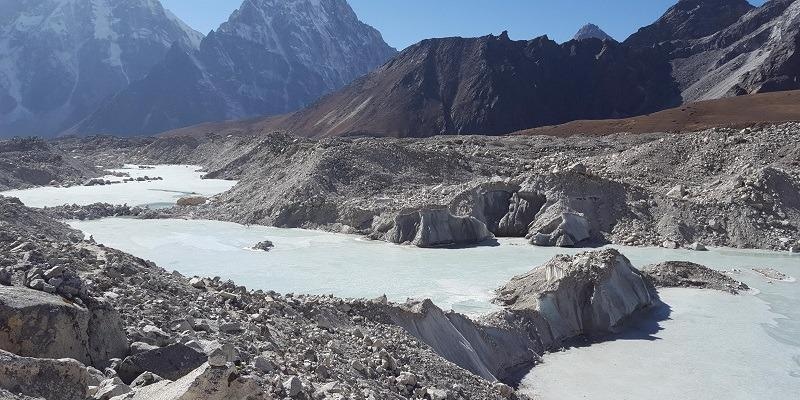A University of Leeds directed study concludes that during the recent decades the Himalayan glaciers have rapidly lost ten times more ice than on average since the last big glacier expansion 400-700 years ago, a period referred to as the Little Ice Age.
 Khumbu glacier pond chain. Image credit: Duncan Quincey, University of Leeds.
Khumbu glacier pond chain. Image credit: Duncan Quincey, University of Leeds.
The study also exposes that Himalayan glaciers are decreasing far more quickly than glaciers in other regions of the world – a rate of loss the scientist's label as “exceptional.”
The research article, which has been published in Scientific Reports, prepared a reconstruction of the ice surfaces and size of 14,798 Himalayan glaciers found in the Little Ice Age. The scientists estimate that the glaciers have lost about 40% of their area – decreasing from a peak of 28,000 km2 to about 19,600 km2 at present.
During that period, between 390 km3 and 586 km3 of ice has vanished – the equivalent of all the ice found at present in the Caucasus, the central European Alps, and Scandinavia combined. The water discharged through that melting has caused sea levels to rise around the world by between 0.92 mm and 1.38 mm, the team estimates.
Our findings clearly show that ice is now being lost from Himalayan glaciers at a rate that is at least ten times higher than the average rate over past centuries. This acceleration in the rate of loss has only emerged within the last few decades, and coincides with human-induced climate change.
Dr. Jonathan Carrivick, Study Corresponding Author and Deputy Head, School of Geography, University of Leeds
Threat to Asia’s River Systems
The Himalayan mountain range hosts the world’s third-largest amount of glacier ice, after Antarctica and the Arctic, and is repeatedly referred to as ‘the Third Pole’.
Meltwater discharged by Himalayan glaciers is the headwater of the largest river systems in Asia. The speed at which the melting of Himalayan glaciers is taking place has significant repercussions for hundreds of millions of people who rely on Asia’s largest river systems for energy and food. These rivers include the Ganges, Brahmaputra and Indus.
Continuing recession and diminishing of Himalayan glaciers raise alarms regarding the sustainability of water supply in the area.
The researchers used satellite images and digital elevation models to create sketches of the glaciers’ extent 400-700 years ago and to ‘reconstruct’ the ice surface. The satellite images exposed ridges that denote the former glacier boundaries, and the team used the geometry of these ridges to approximate the former glacier extent and ice surface height.
By comparing the reconstruction of the glacier to the present-day glacier, the scientist's established the volume and thus the mass loss between the Little Ice Age and the present.
The Himalayan glaciers are mostly losing mass quicker in the eastern regions – taking in east Nepal and Bhutan north of the central divide. The study puts forward this variation is perhaps because of changes in geographical topographies on the two sides of the mountain range and their interaction with the air – resulting in various weather patterns.
Himalayan glaciers are also deteriorating quicker where they end in lakes, which have numerous warming effects, rather than where they end on land. The size and number of these lakes are growing, so persistent acceleration in mass loss can be anticipated.
Likewise, glaciers that have substantial quantities of natural debris covering their surfaces are also losing mass more rapidly: they contributed about 46.5% of total volume loss regardless of making up only about 7.5% of the total number of glaciers.
While we must act urgently to reduce and mitigate the impact of human-made climate change on the glaciers and meltwater-fed rivers, the modelling of that impact on glaciers must also take account of the role of factors such as lakes and debris.
Dr. Jonathan Carrivick, Study Corresponding Author and Deputy Head, School of Geography, University of Leeds
People in the region are already seeing changes that are beyond anything witnessed for centuries. This research is just the latest confirmation that those changes are accelerating and that they will have a significant impact on entire nations and regions.
Dr. Simon Cook, Study Co-author and Senior Lecturer in Geography and Environmental Science, University of Dundee
Journal Reference:
Lee, E., et al. (2021) Accelerated mass loss of Himalayan glaciers since the Little Ice Age. Scientific Reports. doi.org/10.1038/s41598-021-03805-8.